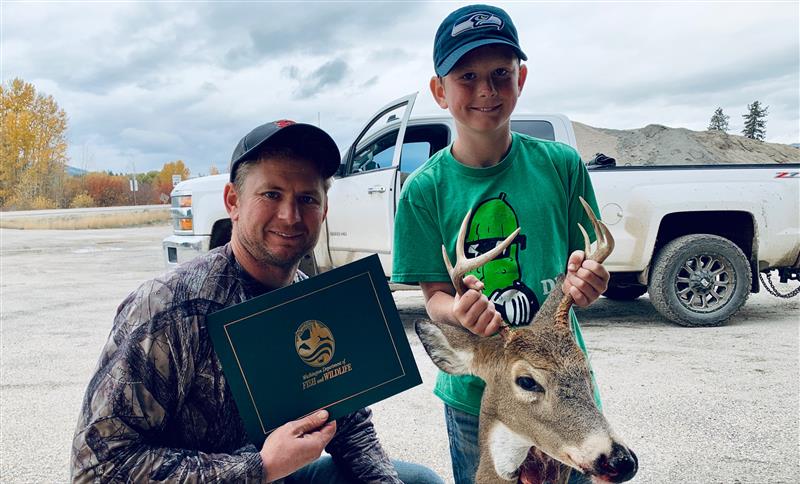
Late NE WA Buck Hunters, Hit Check Stations For CWD Sampling
With Northeast Washington’s highly anticipated late rifle whitetail season opening this Saturday, state wildlife managers are reminding hunters to stop by check stations so they can collect samples from their deer for chronic wasting disease testing.
CWD currently isn’t found here, but WDFW is monitoring deer populations in game management units closest to a Northwest Montana outbreak by adding several more game checks along three major highways over the coming three weekends, as well as taking samples at its Spokane and Colville offices on select weekday afternoons.

With zero ability to treat the deer, elk and moose disease that’s 100 percent fatal and which can lead to population declines, the Evergreen State’s best bet is early detection and prevention, and it behooves us hunters to help that effort as much as possible.
“The early season was pretty slow at check stations and we need to gather a lot more CWD samples,” said Staci Lehman, a WDFW spokeswoman in Spokane, this afternoon.
She said the goal is to collect lymph nodes from 1,200 more whitetails; “several hundred” were taken during October’s rifle season.
WDFW is specifically looking to sample deer killed in the Kelly Hill (105), Douglas (108), Alladin (111), Selkirk (113), 49 Degrees North (117), Mount Spokane (124) and Mica Peak (127) game management units.

All of those (except Mica Peak) plus Huckleberry (121) are open November 6-19 for any whitetail buck. The late season is the best time for riflemen to hunt the species as it overlaps the first half of the primary rut, which peaks around the 20th.
The GMUs also represent four of WDFW’s five whitetail CWD surveillance units, or CSUs.
“We are trying to get 300 samples per CSU to be 95 percent confident that if CWD were present at or below 1 percent prevalence, we would detect it within a population of approximately 15,000 deer,” said Lehman. “However, every sample counts, so even if we aren’t able to reach our target sample size, we will be able to report our confidence level of detecting CWD at or below 1 percent prevalence based on the sample size obtained and the proportion of deer in a CSU that could be infected before we detected CWD given the sample size.”
More information is available in WDFW’s Washington State Chronic Wasting Disease (CWD) Management Plan.
Plans call for further expanded testing in Eastern Washington next year. While CWD has not been found there either, Idaho and Oregon this fall are are also stepping up their testing game.
Two other diseases have been far more of a problem for whitetail hunters this year – bluetongue and epizootic hemorrhagic disease, or EHD, outbreaks – but it’s not clear if that led to relatively low turnout at WDFW’s check stations in October.
Mike Atamian, a wildlife biologist whose district includes the Mt. Spokane and Mica Peak units, thinks those two maladies have resulted in fewer deer available for harvest, while agency outreach about the problem probably also kept some hunters at home or saw them reduce their efforts.
But there’s also much reduced antlerless opportunity due to general season, permit and second tag reductions, Atamian noted, and he added that some hunters focus on mule deer early or decide against taking a small whitetail in October in hopes of bagging a larger one in November.
But even if you don’t tag a deer this month in Northeast Washington, it might be worthwhile to stop at the check stations.
Lehman said it’s an opportunity not only for biologists to talk to hunters about what they’re seeing in the woods, but for sportsmen to ask questions of wildlife managers.
“Check stations are a great chance for us all to learn from each other,” she said.
And if you show up with your first buck, WDFW gives out special certificates, regardless of your age!

Check stations will be open November 6-7 (7:30 a.m.-8 p.m.), 12-14 (9:30 a.m.-7 p.m.) and 18-19 (9:30 a.m.-7 p.m.) along Highway 395 in Colville, Chewelah and Deer Park, Highway 20 in Ione and Usk, and on Highway 2 between Chattaroy and Colbert.
In addition, WDFW’s Colville and Spokane Valley offices are open Mondays and Thursdays from 4-6 p.m. as another “convenient” option for hunters. Best advice is to call (509) 892-1001 to ensure that a staff member is available.
And you can also call the Inland Northwest Wildlife Council at (509) 487-8552 to make an appointment to have your deer sampled at their Spokane headquarters.
“Fighting CWD is a big lift and will take efforts from all in our community,” said Marie Neumiller, INWC executive director.
